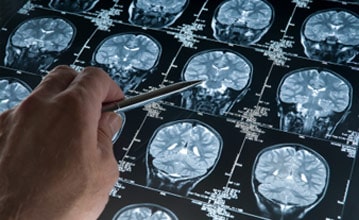Specialist in Electroencephalography Tests (EEG) in Leesburg, VA
What is a Electroencephalography?
An electroencephalogram (EEG) is an electrodiagnostic study that aids in the analysis of the electrical activity of the brain in order to diagnose and evaluate neurological conditions such as epilepsy, seizures, confusional states, coma, and dementia (though not limited to this conditions and/or symptoms). During the study, electrodes are placed on the scalp in a specific configuration to record the bioelectrical activity of the brain, which is interpreted by the physician. Patients may be asked to breathe deeply (unless contraindicated due to a medical condition), look at bright, flashing lights or go to sleep in order for the doctor to collect a range of brain activity. Brain activity is displayed on a computer as a series of wavy lines that are interpreted by the doctor. This test takes one to two hours to perform. Some patients will be required not to sleep the night prior to the study, drink caffeinated products several hours prior to the study, or eat for eat certain foods (i.e. chocolates) before their exam. Our office will provide specific instructions. In some patients with epilepsy, there is a small risk that this procedure may provoke a seizure. However this risk is deemed small and can be handled by your doctor if it does happen. An EEG is a painless diagnostic procedure.
Dr. Seth Tuwiner provides comprehensive testing and treatment for electroencephalography at his office in Leesburg, VA. Learn more about your treatment options and call the Virginia Center for Neuroscience today at (703) 293-5244.
Ambulatory EEG
In some cases, a long term recording may be required. This is called an ambulatory EEG. In this type of study, the patient goes home with the electrodes glued onto the scalp. Similar to an EKG Holter monitor, the electrodes are connected to a portable recorder that is enclosed in a small case/pack, attached to a shoulder strap that is carried home with you. During the 24-72 hours of recording, you are required to document a written diary of your activity and symptoms. You may engage in your normal daily activities (sleeping, eating, working on the computer, and watching TV), though you are requested to avoid engaging in strenuous activity.
Electromyography/Nerve Conduction Studies (EMG/NCS)
Electromyography/nerve conduction studies (EMG/NCS) are useful when evaluating for a peripheral nerve or muscle disorder. This test usually takes 45-90 minutes and comprises two parts. The first part is the nerve conduction study (NCS) and is administered prior to the electromyography (EMG). The NCS measures the speed at which motor and sensory nerves conduct bioelectrical signals (nerve conduction velocity) and the size (amplitude) of the response. Both motor and sensory nerves are tested separately during the NCS. The EMG follows the NCS and measures the electrical activity of the muscle.
Part I. The Nerve Conduction Study (NCS) - During a motor part of the NCS, electrodes are placed on the skin over the motor nerve of a specific muscle or muscle of interest. A short electrical impulse is applied through the electrode and the muscle response is identified, amplified, and shown on a computer. Similarly, during a sensory NCS electrodes are placed on the skin over a sensory nerve of interest. A short electrical impulse is delivered through the electrode and a sensory nerve response is identified, amplified, and analyzed a computer. Various neurological conditions of the peripheral nervous system can uniquely and adversely affect the motor and sensory nerve responses.
Part II. Elecromyography (EMG) - The EMG measures bioelectrical activity inside the muscles. Small, disposable electrodes are placed in the arm and/or leg muscles. The placement of the electrode is dependent on the area of interest and type of peripheral nervous system disorder suspected. The electronic responses are analyzed using a computer. As muscles are activated, they exhibit a bioelectrical signal that can be identified, amplified, and analyzed, providing to the clinician information how they are functioning. Various neurological conditions of the peripheral nervous system can uniquely and adversely affect the muscle responses.
Other Diagnostic Testing and Treatment
In many circumstances, we will refer to other physicians or facilities to perform other types of diagnostic testing and/or treatments not offered by our office. This includes, though not limited to evoked potential studies, brain and/or spine neuroimaging, duplex carotid ultrasound, other non-invasive vascular studies, lumbar puncture, and pain management procedures. This will be discussed in detail during your office visit. If you have any further questions, please contact our office.




